Corliss X's Blog

What is the Inside Zone Read? The Inside Zone Read (IZR) is basic read of the defense best defender with Zone Blocking. Now this is the basis of Oregon's playbook. You must establish the IZR for the OZR, PA, or other reads to work. If the IZR is failing, then the rest of the plays won't work. So when you play NCAA 14 you should first establish the IZR. The IZR always has the running back in a offset position or formation normally 1 1/2 yards split behind the QB; unlike, the IZR, the Outside Zone Read (OZR) has the running back directly beside the QB.
Examples of here of the IZR & OZR:
IZR
OZR
IZR
IZR on NCAA Football 14
OZR on NCAA Football 14
Now notice on the first photo of a IZR the line is shifting? The line shifts over to form a zone blocking concept where it's Man on Man or Hat on Hat, basically each lineman has a man! The tackle or last blocker on the backside of the play lets the DE or best defender go unblock which allows the QB to read him.
As you can see in these two images the zone blocking and the QB reading the defender.
The READ

Now, notice how the QB has his eyes on the defender but the ball is riding the tailback? This is the normal execution of the IZR and OZR. If the defender bites down and aims on tackling the QB then the ball is handed off to the RB. If the defender goes after the RB then the QB is [i]suppose[i]to pull the ball. However, in any offense there are some bending of the rules. Chip Kelly said in his 2009 Coach of the Year Clinic that Oregon WANTS the RB to have the ball.
That's why when playing NCAA Football 14 when in doubt give the ball to the RB. Me and Chip Kelly much rather have the RB getting clobbered than our precious QB !
The Zone Blocking
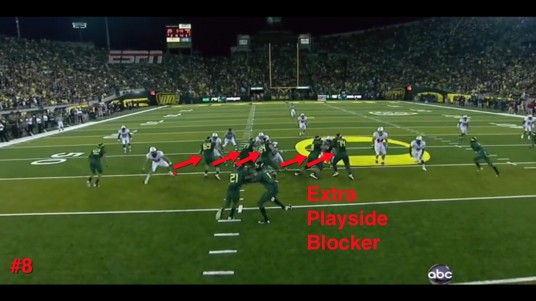
Notice how Oregon's amazing offensive line is shifting the defensive front to the play side of the field? This is normal procedure for the IZR and OZR. You can also notice how each lineman is on one defender. FYI, the playside is direction of the play or the flow of the play; while, the backside of the play is on the opposite end. (TIP: Oregon's linemen are normally undersized for linemen. This makes them quicker, so I recommend you use quicker linemen to run a spread. (The Depth Chart is there for a reason!!)) Oregon line wants to stretch the defense to create huge holes for the RB; as a result, Oregon gains an extra playside defender creating even more hiatus for the D-Line
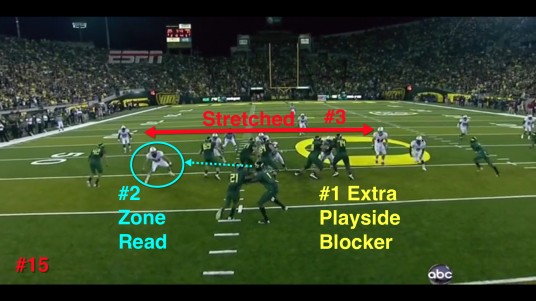
Now the IZR is used on a regular basis while the OZR is used less and less at Oregon. The IZR tightens the defense then you stretch them with the OZR. Does this make sense? Let me explain in depth!
OZR

See how the linemen are still Man on Man or Hat on Hat but the RB is running more so East & West rather than up field ? The IZR and OZR work with each other and against the defense. Now when the RB receives the ball on the IZR or OZR he has Gap Integrity. Gap Integrity means the RB chooses the hole or lane he enters. He must follow strict rules to choosing a hole and adhere to them. Notice on this IZR Oregon's RB, Kenjon Barner, chooses to run pass a defender rather than squeeze through a hole?
IZR Gap Integrity Concept:
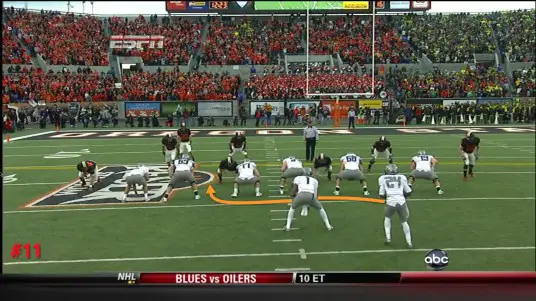
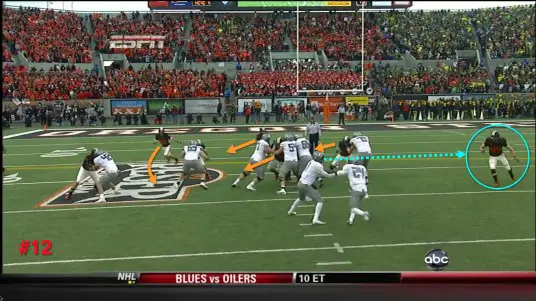
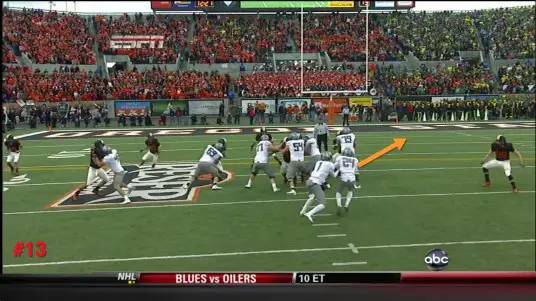
Kenjon Barner eventually rushes pass the defender and the secondary and scores a key Oregon TD in the Civil War game.
Make sure to fully understand the concepts behind the real life IZR and OZR's to use them meticulously on NCAA Football 14. Stay reading!
This entry has not received any comments yet. You could be the first to leave one.
Corliss X
0
Corliss X's Blog Categories
Corliss X's Screenshots (0)

Corliss X does not have any albums to display.
Corliss X's Friends
Recent Visitors
The last 10 visitor(s) to this Arena were:
Corliss X's Arena has had 107,397 visits
- awil1026
- brock0730
- CoachRich
- jgthedon
- Lewisf33
- majorvendetta
- opifex
- Rcktfan916
- Sports_Gamer07
- wino1618
Corliss X's Arena has had 107,397 visits


